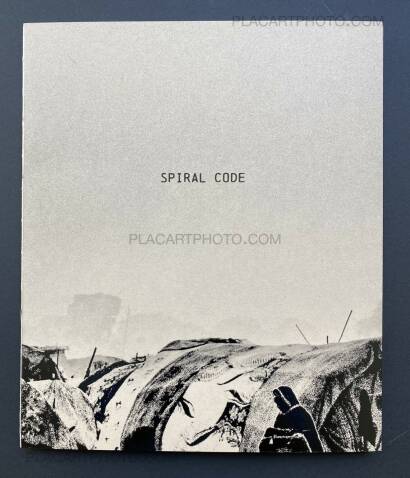SPIRAL CODE (edt of 350)
.jpg)
Wataru Igarashi
SPIRAL CODE (edt of 350)
Photographs: Wataru Igarashi
Text: Wataru Igarashi & Marc Feustel
Publisher: The Art Book Collective / The Tokyo Photobook Review
92 pages
Year: 2023
Price: 55 €
Comments: Softcover, 25 x 21 cm, b&w photographs. First edition of 350 copies, including 20 special editions. Text in Japanese and English. Design: Laurent Chevrier. Arrival soon
Early 2011. I was staying under the canopy of a shrine in the town of Pokhran in the state of Rajasthan. One day, my former landlord's wife had suddenly started screaming in the middle of the street as if she had lost her mind. She had then taken me to this sanctuary which was rumored to cure disabilities and mental disorders thanks to a strong magnetic field.
After a journey of over 500km by train, bus and taxi, I found myself in this magnetic field where a hundred believers were living in tents.The trance-like prayers of a crowd of disabled and mentally ill people instilled fear in me. While I spent my time helping people to eat while feeling distressed and unable to get my camera out, I realized that a week had passed.As I gradually became familiar with them by sharing their daily lives, I was finally able to take out my camera. Over the next nine years, I spent over four hundred days in five different sanctuaries, until the coronavirus pandemic took over the world.
These places, which cannot be described by language, kept stimulating my dormant sub-conscious. Living with people who believed deeply in invisible existences made me feel a strange nostalgia. For me, growing up in Japan with the aid of modern medicine, the magnetic field appears like a giant shaman. The field reveals the inherent dynamism and wildness of humanity and enhances our natural healing power through the belief in a higher being and the earth's power.
I had the sensation of observing the parallel world that lies beyond self-awareness. This was somehow related to photography which can be connected with this other world while capturing visible concrete elements. As I think back to this time, those captured in my photographs are like a representation of myself going about my daily life. I spent days trying to get their secret nen, like a code printed in their DNA, by taking pictures of them without resorting to words. I now feel that the great invisible can give a positive meaning to our existence.
- WATARU IGARASHI
Heaven is under our feet as well as over our heads. - Henry David Thoreau
In the "developed" world, we understand time as a linear construct, punctuated by a beginning and an end. Within that conception, the basic unit is that of our own lifetime, bookended by our birth and our death. In fact, it seems that we increasingly struggle to project our thinking beyond that narrow window.
In many other belief systems, time is not understood as linear but as cyclical. According to the kalachakra, or wheel of time, which runs through many of India's main religious traditions and philosophies--Buddhism, Hinduism, Jainism, Sikhism-time consists of a series of repeating ages. In these systems of thought, the universe goes through constant cycles of birth and rebirth while progressing towards the goal of moksha or enlightenment. Time, which is therefore both linear and cyclical, progresses as a spiral.
The images in Spiral Code speak to that cyclical conception of time, to that of an epoch rather than the blip constituted by a single lifetime. While these photographs are taken in a handful of locations in Central India over the course of a decade, they contain little sense of chronology or of geographic location. The people depicted in these images have come in search of a form of telluric care through the magnetic qualities the earth is said to possess in these remote locations. Often treated as outcasts due to mental or physical disabilities, they have turned towards the earth to find healing. This conception of nature and our place in it, much like that of time, is unlike our Western binary framing. Here, everything that is born dies and everything that dies is recreated in another form.
This cycle is starkly apparent in Wataru Igar-ashi's images as beings--humans, animals.-of all ages gather amidst the dust, sand, mud, and dirt. In one photograph, a young woman is curled up in the foetal position in a crater, her body itself forming a spiral. Is she emerging from the earth or being swallowed up by it? This image could be seen either as a beginning or as an end, but perhaps it is above all a reminder of the cycles of which we are all a part.
- MARC FEUSTEL
.jpg)
.jpg)
.jpg)
.jpg)
.jpg)
.jpg)
.jpg)
.jpg)
.jpg)
.jpg)
.jpg)
.jpg)
.jpg)
.jpg)
.jpg)
.jpg)
.jpg)
.jpg)
.jpg)
.jpg)
.jpg)
.jpg)
.jpg)
.jpg)
more books tagged »india« | >> see all
-
THE COAST (SIGNED)
by Sohrab Hura
Euro 400 -
Portraits, the people of VARANASI (Signed)
by Tadayuki Kawahito
sold -
The Light that has lighted the world (Signed)
by Kiyoshi Suzuki
sold -
1528 (Signed and numbered of 300 copies)
by Rohit Saha
sold -
INTOUCHABLES (NUMBERED)
by Olivier Culmann
Euro 15 -
Aum (Signed, edt of 50)
by Martì Gasull
Euro 90
more books tagged »japanese« | >> see all
-
Torii
by Risaku Suzuki
Euro 50 -
Let us know about Okinawa (Signed)
by Ari Hatsuzawa
sold -
Egg 1975, 7, 16〜8,15 (Signed)
by Kowa Kato
price on request -
Waisetsu Shashin (Obscenities)
by Nobuyoshi Araki
Euro 80 -
JP-01 SPK (Signed)
by Taiji Matsue
sold -
IMMERSE
by Daisuke Yokota
Euro 250
Books from the Virtual Bookshelf josefchladek.com













;jpg)

;jpg)



 Facebook
Facebook Instagram
Instagram